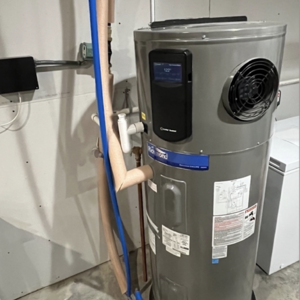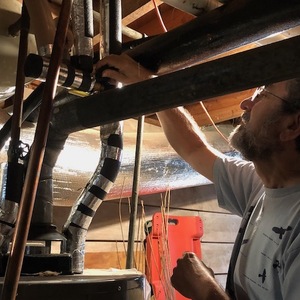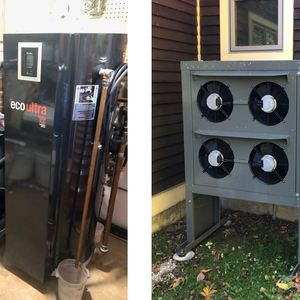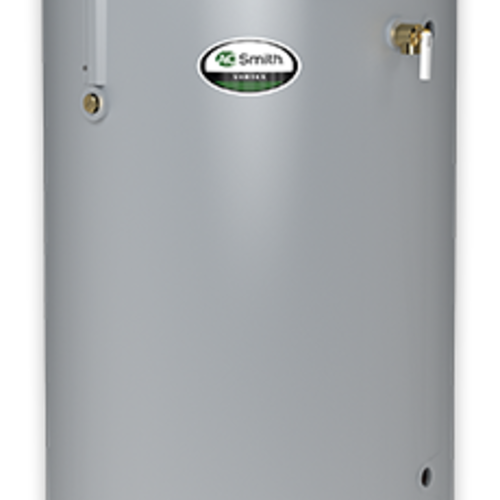
Domestic hot water systems account for one fifth of household energy use, contributing to expenses and carbon emissions. To lower those numbers, I re-engineered the hot water system in our century-old home (Climate Zone 4) to take advantage of 1. hybrid water heaters, which have become common and less expensive, 2. the existing boiler and its indirect, and 3. the thermodynamics of our basement and house taken as a complete system. While this was a retrofit, the setup and the logic behind it can be used for new construction as well.
Shortcomings of standard systems
Conventional hot water systems have inherent inefficiencies and challenges; there’s the high operational costs of electric resistive water heaters and the environmental toll of natural gas. When located in the basement, as in the case at our house, they add heat to basements. This waste heat then bleeds into the ground, accounting for up to 1/3 of the heat loss in an average home.
Many green hot water solutions, from solar hot water to tankless natural gas, have drawbacks including initial cost and ongoing maintenance. Tankless water heaters give up any buffer capacity in exchange for minimizing the already-minimal heat losses from a modern, insulated tank. This necessitates all heat output be created instantaneously, and can result in cold water at low flow rates before the burner kicks in.
The most comfortable solution for homes with a boiler is often thought to be an indirect tank, but the impressive hot water production rates of these are offset by the inefficiency of running the boiler periodically all summer, which then radiates its heat to the basement or utility closet. Natural gas tank heaters have a slower but still fast recovery rate, cannot be as well insulated as other tanks, and produce emissions. Electric-resistive tank heaters have a slow recovery rate…
Weekly Newsletter
Get building science and energy efficiency advice, plus special offers, in your inbox.

This article is only available to GBA Prime Members
Sign up for a free trial and get instant access to this article as well as GBA’s complete library of premium articles and construction details.
Start Free TrialAlready a member? Log in















24 Comments
"When located in the basement, as in the case at our house, they (conventional water heaters) add heat to basements. This waste heat then bleeds into the ground, accounting for up to 1/3 of the heat loss in an average home."
That's not what the link says. It says uninsulated basement walls can account for up to 1/3 of the heat loss in houses - a very different claim.
I'm also unclear as to how conventional water heaters would add more "waste" heat than a buffer tank., or why in a heat dominated climate "waste" heat is much of a problem.
My interpretation of this was that by overheating the basement, you are actually increasing the heat loss through the potentially uninsulated walls/slab. Not sure the math really checks out here though, if your first floor framing is uninsulated.
I do think it's a good use of the indirect tank to get the fast heat recovery only on the occasion it's needed. Otherwise, just buying the 80gal tank would have achieved basically the same results.
Tim_O,
I don't know enough about them to weigh in on the merits of the system he came up with, just the narrower issue of his justification for doing so.
Heat comes from a variety of sources - primarily the dedicated heating system, but also from occupants, solar gain, and as a byproduct of equipment like wiring, computers, light bulbs, and water heaters, ovens, etc.
As DC says, the house doesn't really differentiate what source it comes from. I guess the only meaningful distinction between them would be the cost to produce each one. All that has nothing to do with whether a house has some weak building assembly that loses a lot of heat - and I don't think it makes sense to address that by producing less heat.
Hi everyone. Thanks for the interest in this and sorry for the delay while I got access to my account.
Definitely didn’t intend to imply that the extra heat produced in the basement accounted for 1/3 of the house’s heating loss, just that in insulated basements are a substantial source of heat loss and thus moving some of that heat into hot water is a fairly big win. The statistic I’d have preferred to use is the approximate percent of each unit of heat in the basement that winds up back in the conditioned spaces of the house vs wasted heating the ground—if anyone has such a source I’d appreciate it.
There was a pervasive belief in the 20th century that heat only went where you put it, that if you had unheated spaces in your home they didn't lose any heat. You can see it in the way many old houses are insulated, that the attics, crawl space and basements are uninsulated because they were unheated.
That attitude still exists, as evidenced by this article. Sure, the warmer your basement, the more heat it loses. But it's really not true that heat lost by the basement is "waste" heat, if the basement weren't heated that heat would still be coming from the rest of the house.
It is complicated a bit because underground temperatures tend to stay more stable than above ground, so basements tend to stay warmer than similarly insulated above-ground spaces. But the idea that you can get "free" heat out of your basement by cooling it to below ground temperature is nonsense. The basement is still connected to the house, the temperature difference between the house and the basement is much greater than the difference between basement and ground, and the insulation is less, and so the lion's share of the heat is coming out of the house and not out of the ground.
I guess it could have been worse. He could have mentioned "thermal mass."
When we moved it our basement was hotter than the house in winter. After insulating every boiler pipe I could see it then ran about the same as the house (70 or so). Now it seems to run quite a bit cooler with the heat pump. Definitely not suggesting that cooling the basement below ground temp would be efficient or desirable. Just that if the basement is already warm, a heat pump in that space isn’t just exclusively moving heat that would have otherwise ended up in a conditioned space.
I am skeptical about a couple of things here.
Boiler indirects with high-mass boilers are notoriously inefficient in the non heating season. The boiler may have a combustion efficiency of 85%, but the delivered efficiency for hot water in the non-heating season (when 300-400pounds of cast iron in the boiler might have to be brought up to 160 degrees in order to put a few thousand btus into the indirect to compensate for standby losses ) drops considerably. Maybe tricking out set points so that hot water demand allows the hp water heater to add btus to the indirect offsets this somewhat, but I’d be careful about ignoring that factor entirely.
With regard to dehumidification, the moisture removal of a hpwh is on the order of 1/10th that of a typical dehumidifier—maybe 3 pints per day instead of 30. So although it’s beneficial, it won’t usually take the place of a dehumidifier if one is necessary.
And in the cooling season all that extra heat has to be removed by the cooling system.
I agree. For a retrofit, adding the heat pump before the indirect made it so the boiler rarely has to run to deliver hot water. Only in times of super high demand does it kick in, and then it’s just as inefficient as before but no saves people from a cold shower.
GBA, what is a junior faculty in an emergency medicine department doing having his thoughts on water heaters published? Are you really this desperate for content these days?
Then again we can thank the author for presenting an easily refutable case of why two stage water heaters make no sense in terms of carbon reductions, economics, or thermodynamics.
Sorry, Ari.
Definitely not my choice to list title, and it seems I’m stuck with them whenever I post now 🫤.
Would love your thoughts on disadvantages of two stage systems for this use case, and we can explore together and I can learn.
Thanks,
Ari
"When we first moved in it was sometimes 80°F down there in the dead of winter. After insulating every boiler pipe I could see, it cooled down to 70°F, but from my readings on Green Building Advisor that still meant most of the heat was escaping into the ground rather than the house."
The biggest source of heat loss from basements is the exposed above-grade wall, and the "shallowly buried" part of the wall. Dirt acts as an insulator (poorly)--as John Straube puts it, that's why they sell dirt in the landscaping aisle instead of the insulation aisle at Home Depot.
This is pretty obvious if you ever look at a basement wall with an infrared camera--the above-grade portions are the cold surfaces (assuming no insulation). In case you're wondering, the windows are warmer surfaces than the uninsulated walls in the images below because (a) they have a storm panel, so maybe R-2.5, and (b) the sun is hitting one of them.
Note also that if the basement is at 80F and the first floor of the house is at 70F, there is going to be significant heat flow from the basement into the first floor. It's basically like having radiant floor heat. If you then reduce the basement to 70F that heat flow goes to zero, so that heat now has to be provided to the first floor by the heating system.
That makes sense, thanks. Most of our basement is below ground, only the top two feet maybe are above ground. I wish I had better numbers on basement heat loss to help guide this.
All of this seems to boil down to: does it make sense to put a HPWH in the basement, though, and my understanding is that far more knowledgeable people than I think it’s still more efficient than an electric tank or natural gas. I’m learning a lot from your comments, thanks, and seeing scenarios I didn’t think about at all because I was just doing my own home.
Dr. Ari B. Friedman, MD, PhD, you are a nerd after my own heart and I hope you just let the haters hate. :) I'm not saying there are no possible arguments against your presentation, but the devil is in the details and the contrarians don't know enough about the actual existing conditions at your home (in terms of the thermal or air barriers between your basement and conditioned space, etc.).
You should come back next year and tell us how well your usage and bill tracked with your predictions.
Also, how much did Trusty Plumber charge you to connect all that copper, and why isn't it insulated if it's in the cold basement? Thanks.
edubin,
From the blog:
"Due to the placement of the existing indirect and boiler, the connection between the tanks was quite long. This should ideally be very short to minimize losses. Instead, we carefully insulated. First, the pipes were wrapped with 1-in. Wall Insul-Lock DS pipe insulation (R-7.2). Over that we wrapped 1-1/2 in. of fiberglass wrap. Finally, a plastic vapor barrier was wrapped for the final layer. This R-value is less than half of what a modern hot water tank uses but should reduce many of the losses for the water in that connection."
Thanks edubin. I’m definitely a nerd lol. Just grateful to be here to learn.
Like Malcolm says I did insulate the connection between tanks heavily and I would guess not doing so would waste more energy than not insulating regular hot water pipes since it’s running a bit hotter and drawn into those pipes whenever any hot water in the house is used.
Also worth noting that I’m not trying to model whether a HPWH is more efficient. Many more capable people have done that. DCcontrarian’s writings are very interesting on this topic.
Instead, I think the retrofit aspect in this two-stage setup allows us to:
1. Use the cheapest possible HPWH
2. Turn off the resistance element in it
3. Allow for separate thermostats for the HP and the backup (in this case, the boiler)
Those factors, in turn, means the tiny little heat pump can run more of the day and provide more of the heat output.
I'm wondering if you're relying only on the flow of water from the HPWH into the indirect during times when the domestic hot water is being used in order to transfer heat from the HPWH to the indirect, or if you have some sort of temperature controlled circulator that is moving the higher temp water from the HPWH to the indirect (and cooler water from the indirect back into the HPWH) during times of low domestic hot water usage? Or are you using domestic hot water enough that that isn't needed, and if the indirect cools off during a period of time of low domestic hot water usage that the boiler just kicks on to top it back off?
This idea of running a HPWH in series with an indirect has been on my mind for a while, and this was something I was wondering about.
I insulated the pipe between the two tanks well, but don't have a circulator pump.
There's a 10 degree difference between the two tanks as I have them set currently (130 -> 120). So even if the indirect loses 1 degree F per hour overnight, it will basically never kick in.
https://www.greenbuildingadvisor.com/question/water-heater-standby-losses
The one opportunity I've had to test it so far (warm weather for a few weeks), the boiler clock which reads in hours didn't advance at all. So it's not kicking in much if it's kicking in at all.
Thank you! That's great info, I appreciate it. Sounds like this might work for me. Now I just have to figure out how to fit a heat pump water heater in my mechanical space. I really wish they made a lowboy version, as I have limited height.
I also have limited height in my basement. I had given up on 80 gallon HPWHs until I found that the newer AO Smith Voltex AL models are shorter than the competition, and have the option to use water connections on the side rather than the top.
Ari -
First, many thanks for taking the (considerable) time and effort to document and then being willing to share your rationale and the implementation. We need pioneers. And thank you for using this as a learning experience and maintaining such a respectful, open-minded attitude. It's an interesting and imaginative approach to solving the issues you were (emphasize past tense) facing. And it has generated an informative discussion.
Thank you! I've learned a ton from the contributions here and on BuildItSolar, so felt nice to give back in my own way. Appreciate the kind words.
Log in or become a member to post a comment.
Sign up Log in